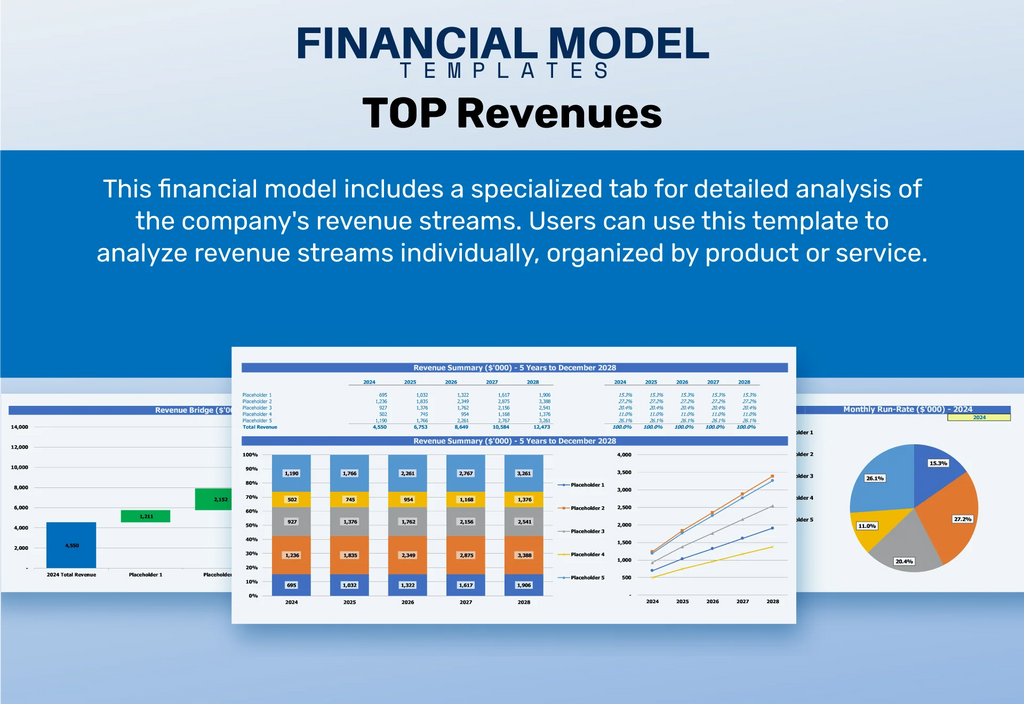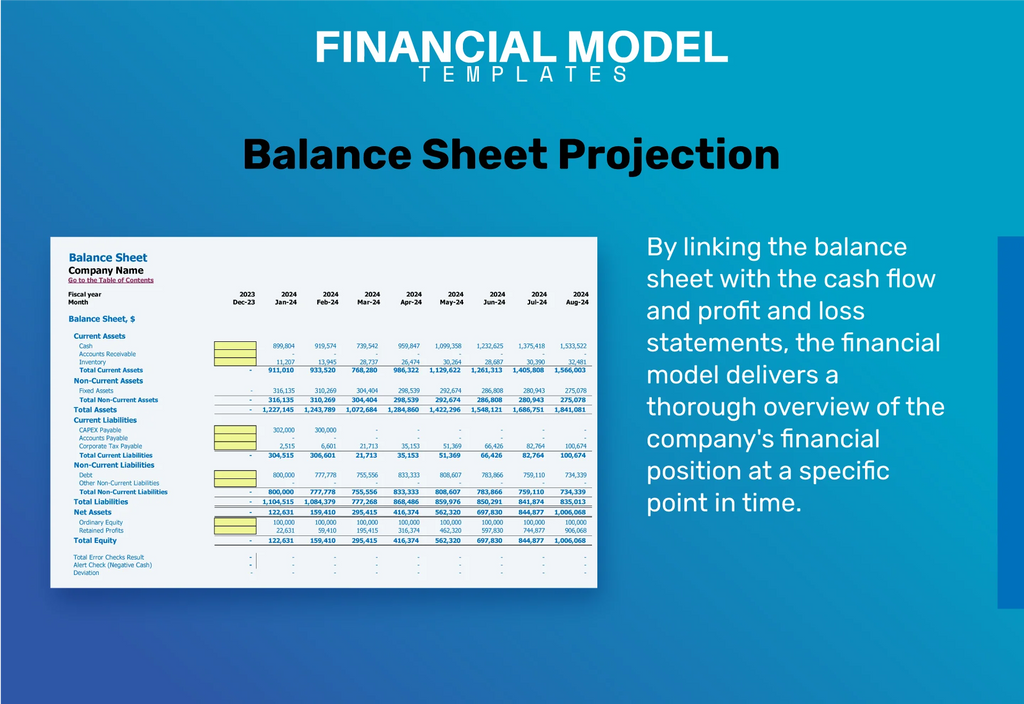International Language School Financial Model

- ✔ 5-Year Financial Projections
- ✔ 100% Editable
- ✔ Investor-Approved Valuation Models
- ✔ MAC/PC Compatible, Fully Unlocked
- ✔ No Accounting Or Financial Knowledge
International Language School Financial Model
Bundle Includes:
ALL IN ONE MEGA PACK - CONSIST OF:
international language school Financial Model/Business Plan Excel Template
Pitch Deck Template For PowerPoint, Keynote & Google Slides
Business Plan Guide and Business Plan Template in MS Word Format
Financial Dashboard in Excel To Track Your Business Performance
INTERNATIONAL LANGUAGE SCHOOL FINANCIAL MODEL FOR STARTUP INFO
Highlights
International language school financial modeling is an essential strategy for startups and established institutions aiming to attract investment and plan for sustainable growth. By implementing a comprehensive financial plan for language schools, including tuition fee structures and operational costs, institutions can enhance their budgets and effectively manage expenditures. Financial sustainability in language education requires robust marketing strategies and accurate student enrollment forecasting, which together contribute to profitability analysis for language schools. Additionally, exploring investment opportunities in language education and offering tuition assistance programs or scholarship funding for language learners can diversify revenue streams while addressing financial risks. Utilizing tools such as a cost-benefit analysis of language courses and a financial risk assessment for schools provides critical insights for maintaining high-quality international language programs while ensuring robust financial projections for future success.
The financial model for language schools addresses key pain points by providing a comprehensive overview of operational costs, tuition fee structures, and revenue streams, which facilitates effective budget management and financial sustainability. Users can easily navigate through detailed sections on student enrollment forecasting and profit margins, enabling cost-benefit analyses of language courses. Additionally, the model assists in financial risk assessment and projections, helping institutions evaluate their investment opportunities and optimize scholarship funding and tuition assistance programs for learners. By using colorful tables and charts for visual clarity, the template enhances decision-making processes and allows for real-time adjustments that reflect changing global language school trends and staffing expenses.
Description
The international language school financial modeling template is designed to be flexible and comprehensive, integrating essential financial calculations and valuation charts that facilitate effective business reporting and decision-making. It allows users to construct a detailed financial plan that captures startup costs, initial capital investments, and working capital needs, enabling accurate forecasting of monthly sales and operational costs. Additionally, the model provides a 5-year projection, accommodating both new startup initiatives and established language schools by incorporating a revenue forecast and expense budget. It emphasizes the importance of financial sustainability, helping to assess student enrollment forecasting and marketing strategies while ensuring a rigorous financial risk assessment. This tool is crucial for managing tuition fee structures, staffing expenses, and other expenditure types, ultimately supporting negotiations with investors and enhancing profitability analysis within the language education sector.
INTERNATIONAL LANGUAGE SCHOOL FINANCIAL MODEL REPORTS
All in One Place
A robust business plan Excel template is essential for language schools seeking financial sustainability and growth. Key features include versatility and organization, enabling users to model various scenarios, such as tuition fee structures, operational costs, and staffing expenses. This powerful financial projections tool allows for seamless adjustments to align with unique institutional needs. By incorporating student enrollment forecasting and profitability analysis, schools can refine their marketing strategies and explore investment opportunities. Ultimately, an effective financial plan promotes sound budget management and enhances the potential for success in the competitive landscape of international language education.

Dashboard
The Dashboard tab in our business plan template provides a comprehensive financial overview, presented through engaging graphs, charts, and key ratios. This visual representation allows for a quick assessment of your language school's financial health, including budget management and revenue streams. Easily integrate these insights into your pitch deck to illustrate your operational costs, tuition fee structures, and profitability analysis. Leverage this data to enhance your marketing strategies, forecast student enrollment, and ensure financial sustainability in language education. Prepare to seize investment opportunities that will elevate your institution's impact and reach.

Business Financial Statements
To attract investors and lenders, a robust financial plan for language schools is essential. Your business plan should feature flexible financial projections that accurately capture revenue streams, from tuition fee structures to scholarship funding. Include a detailed profitability analysis and cost-benefit assessments to showcase operational costs and expenditure types. Highlight marketing strategies that enhance student enrollment forecasting and identify investment opportunities in language education. With effective budget management and financial risk assessments, your language institution can achieve financial sustainability and growth in an increasingly competitive market.

Sources And Uses Statement
Our financial planning template simplifies the sources and uses of cash statement, offering clarity to stakeholders about financing needs and strategies. It demonstrates to current investors potential alternative funding sources, enhancing financial sustainability in language education. This is particularly vital for startups, which might consider innovative solutions like crowdfunding. The statement emphasizes a balanced approach: total funds sourced must align with planned expenditures. By implementing this model, language schools can better project student enrollment, optimize tuition fee structures, and assess financial risks, ultimately driving profitability and growth in a competitive global landscape.

Break Even Point In Sales Dollars
This break-even analysis report provides critical insights into the annual revenue required for financial sustainability in language education. By examining total variable and fixed costs, it outlines the timeline for achieving profitability, highlighting the number of months necessary to reach the break-even point. This analysis is essential for informing financial projections and budget management, allowing language schools to strategize effectively for student enrollment forecasting and operational efficiency. Understanding these metrics ensures that language institutions can explore investment opportunities while maintaining robust tuition fee structures and minimizing financial risks.

Top Revenue
In developing a robust financial plan for language schools, revenue forecasting is paramount. By utilizing historical data, schools can establish realistic growth assumptions that drive key financial metrics and overall valuation. Effective budget management hinges on understanding various revenue streams, along with operational costs and expenditure types. Leveraging our three-year financial projection template, language institutions can enhance their profitability analysis, ensure financial sustainability, and identify investment opportunities in language education. A strategic focus on student enrollment forecasting and tuition fee structures will further position language schools for long-term success.

Business Top Expenses Spreadsheet
To achieve financial sustainability in language education, it's crucial to analyze and optimize operational costs. Our financial model template for startups includes a detailed top expense report, categorizing major expenditures and others for streamlined monitoring. This tool enables language schools to effectively track trends in costs, facilitating informed budget management. By maintaining a keen eye on tuition fee structures and student enrollment forecasting, institutions can enhance profitability. Strategic financial planning and risk assessment are essential in navigating the dynamic landscape of global language school trends to ensure lasting success.

INTERNATIONAL LANGUAGE SCHOOL FINANCIAL PROJECTION EXPENSES
Costs
Every language school faces initial start-up costs that significantly impact financial sustainability. Effective budget management and operational cost monitoring are crucial to prevent underfunding and unexpected expense surges. Within our financial plan for language institutes, we provide a detailed proforma that outlines anticipated expenditures and funding strategies. Utilizing this proforma enables language school owners to track expenses, assess profitability, and develop robust tuition fee structures. By leveraging this financial tool, schools can ensure sound investment opportunities and make informed decisions, ultimately enhancing student enrollment forecasting and paving the way for lasting success in the competitive language education market.

CAPEX Spending
A robust capital expenditure plan is essential within the financial plan for language schools. Effective capital budgeting analysis aids in accurately forecasting start-up expenses and monitoring investments, ultimately influencing cash flow. By meticulously detailing expenditure types, language institutions can enhance their budget management practices. This comprehensive approach is vital for establishing financial sustainability and identifying investment opportunities in language education. Furthermore, understanding operational costs allows schools to optimize tuition fee structures, ensuring profitability while meeting student needs through programs like tuition assistance and scholarship funding. Engaging in this analysis positions language schools for long-term success in a competitive market.

Loan Financing Calculator
Start-ups and growing language schools often face financial challenges, needing to secure loans for operational and expansion costs. Integrating a loan repayment schedule into a comprehensive financial plan is crucial for effective budget management. This schedule, detailing repayment amounts and terms, serves as a vital component of cash flow analysis and impacts projections across financial metrics. Monitoring these elements helps institutions analyze profitability, assess financial sustainability, and identify strategic opportunities for student enrollment forecasting, tuition fee structures, and marketing strategies. Ultimately, robust financial modeling equips language schools to thrive sustainably in a competitive market.

INTERNATIONAL LANGUAGE SCHOOL EXCEL FINANCIAL MODEL METRICS
Financial KPIs
A robust gross profit margin (GPM) is a vital indicator of financial sustainability in language schools. It highlights the difference between revenue streams and operational costs, providing insight into the institution's profitability. An improvement in GPM reflects reduced expenses related to program delivery and enhanced tuition fee structures, driving positive financial projections. By analyzing GPM as a percentage, language institutions can effectively assess financial risk, implement strategic marketing initiatives, and identify investment opportunities, ultimately ensuring sound budget management and increased student enrollment forecasting.

Cash Flow Forecast Excel
Stakeholders, including banks, often require a comprehensive financial plan for language schools before approving loans. Demonstrating financial sustainability through a robust cash flow forecast is essential, as it validates your pro forma income statement's capability in managing funds efficiently. A thorough profitability analysis and an understanding of operational costs, tuition fee structures, and student enrollment forecasting can further reinforce your financial model. By showcasing effective budget management and investment opportunities, you can instill confidence in stakeholders, ensuring adequate resources for growth and operational stability in the competitive landscape of international language education.

KPI Benchmarks
A financial forecast template's benchmark tab evaluates key performance indicators against industry averages, providing critical insights for language schools. This benchmarking analysis is vital for effective financial planning, particularly for startups in the language education sector. By identifying "best practices" within the industry, language institutions can assess their financial sustainability, optimize tuition fee structures, and enhance budget management. This strategic tool not only informs profitability analysis but also aids in forecasting student enrollment, ensuring that language schools remain competitive and financially robust in the evolving global landscape.

P&L Statement Excel
The projected income statement serves as a robust financial plan for language schools, streamlining financial reporting and enhancing accuracy in calculations. This tool not only evaluates profit and loss but also assesses profitability and growth potential within the international language education model. By analyzing key indicators, it facilitates informed decision-making regarding revenue streams and operational costs. This comprehensive approach supports effective budget management, student enrollment forecasting, and the identification of investment opportunities, ensuring financial sustainability and success in the competitive landscape of language education.

Pro Forma Balance Sheet Template Excel
We have included a projected balance sheet template, an essential tool for every language school. This report outlines current and long-term assets, liabilities, and equity, providing a comprehensive financial overview. Additionally, the pro forma balance sheet offers crucial data for conducting profitability analysis and financial risk assessments, enabling effective budget management. Understanding these financial dynamics is vital for forecasting student enrollment and ensuring financial sustainability in language education. This strategic insight aids in decision-making regarding tuition fee structures and operational costs while identifying investment opportunities for future growth.

INTERNATIONAL LANGUAGE SCHOOL FINANCIAL PROJECTION TEMPLATE VALUATION
Startup Valuation Model
Explore our comprehensive financial plan for language schools, designed to enhance profitability and facilitate sustainable growth. Our international language education model incorporates a detailed valuation analysis template, enabling effective tuition fee structures and cost-benefit analysis of language courses. Benefit from robust student enrollment forecasting and marketing strategies tailored for operational efficiency. Assess staffing expenses, operational costs, and investment opportunities to ensure financial sustainability. With tools for financial risk assessment and projections, our model empowers language institutions to navigate global trends and secure scholarship funding and tuition assistance programs for aspiring language learners.

Cap Table
The Capitalization Table provides a comprehensive overview of a language school's financial health. It details ownership structures, illustrating share percentages held by investors, alongside capital expenditures. By incorporating equity shares, preferred shares, and options, the cap table is an essential tool for language school budget management. This financial plan underpins crucial decision-making regarding revenue streams, operational costs, and investment opportunities in language education. Understanding these financial metrics is vital for fostering financial sustainability and aligning strategies with global language school trends.

KEY FEATURES
A robust financial plan for language schools enhances profitability, ensuring sustainable growth and attracting more investors in international education.
A robust financial plan for language schools enhances financial sustainability and maximizes profitability while ensuring effective budget management.
A robust financial plan for language schools enhances profitability by optimizing revenue streams and reducing operational costs effectively.
The international language school business forecast template simplifies financial planning, enabling growth while eliminating complex technical requirements and costs.
An effective financial plan for language schools enhances revenue streams while ensuring sustainability and strategic growth in education.
This comprehensive financial model empowers language schools to ensure profitability and sustainability, regardless of their size or development stage.
An integrated financial model enhances profitability and sustainability for language schools by optimizing revenue streams and managing operational costs effectively.
The financial projection model streamlines assumptions and outputs, enhancing investor confidence and promoting sustainable growth for language schools.
An effective financial plan for language schools enhances revenue streams, ensuring sustainability and strategic growth in a competitive market.
An effective financial plan enhances profitability and sustainability for language schools through precise budgeting and comprehensive forecasting reports.
ADVANTAGES
A comprehensive financial plan for language schools enhances profitability, ensuring sustainable growth while effectively managing operational costs and revenue streams.
An effective financial plan for language schools enhances profitability by optimizing revenue streams and managing operational costs efficiently.
Utilizing the international language school startup financial model enhances budget management and boosts revenue streams for sustainable growth.
Implementing a robust financial plan enhances revenue streams and ensures long-term sustainability for international language schools.
An effective financial model enhances revenue streams and ensures sustainability for language schools through strategic budgeting and forecasting.




